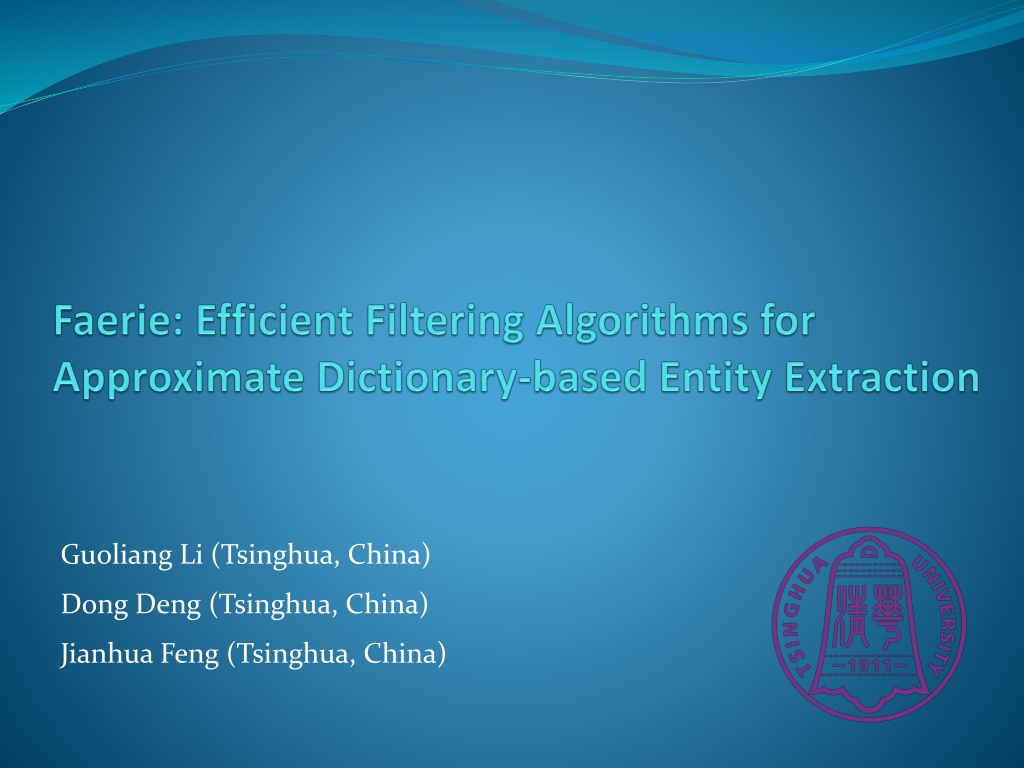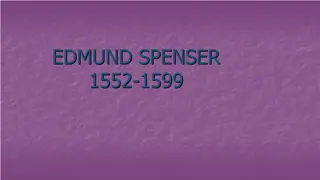
Advanced Entity Extraction Techniques and Algorithms
Explore cutting-edge entity extraction methods and algorithms including dictionary-based named entity recognition and approximate entity extraction. Learn about real-world data challenges and solutions, as well as automated link addition to enhance information retrieval. Discover how these techniques are revolutionizing information processing and analysis for various applications in the digital age.
Download Presentation

Please find below an Image/Link to download the presentation.
The content on the website is provided AS IS for your information and personal use only. It may not be sold, licensed, or shared on other websites without obtaining consent from the author. If you encounter any issues during the download, it is possible that the publisher has removed the file from their server.
You are allowed to download the files provided on this website for personal or commercial use, subject to the condition that they are used lawfully. All files are the property of their respective owners.
The content on the website is provided AS IS for your information and personal use only. It may not be sold, licensed, or shared on other websites without obtaining consent from the author.
E N D
Presentation Transcript
Guoliang Li (Tsinghua, China) Dong Deng (Tsinghua, China) Jianhua Feng (Tsinghua, China)
Outline Motivation Preliminaries A Unified Framework Heap-based Filtering Algorithm Improving The Single-heap-based Method Experiment Conclusion Faerie @ SIGMOD2011 2025/3/20 2/44
Named Entity Recognition Dictionary-based NER Documents Dictionary of Entities 1 Sir Isaac Newton was an English physicist, mathematician, astronomer, natural philosopher, alchemist, and theologian and one of the most influential men in human history. His Philosophi Naturalis Principia Mathematica, published in 1687, is by itself considered to be among the most influential books in the history of science, laying the groundwork for most of classical mechanics. Isaac Newton Sigmund Freud English Austrian physicist mathematician astronomer philosopher alchemist theologian psychiatrist economist historian sociologist ... 2 Sigmund Freud was an Austrian psychiatrist who founded the psychoanalytic school of psychology. Freud is best known for his theories of the unconscious mind and the defense mechanism of repression and for creating the clinical practice of psychoanalysis for curing psychopathology through dialogue between a patient and a psychoanalyst. Faerie @ SIGMOD2011 2025/3/20 3/44
Automatically add the links Wikipedia http://en.wikipedia.org/wiki/Levenshtein_distance Faerie @ SIGMOD2011 2025/3/20 4/44
Real-world Data is Rather Dirty DBLP Complete Search Typo in author Argyrios Zymnis Argyris Zymnis Typo in title relaxed related Faerie @ SIGMOD2011 2025/3/20 5/44
Approximate Entity Extraction Approximate dictionary-based entity extraction finds all substrings from the document that approximately match the predefined entities. For example: Dictionary of Entities Documents Isaac Newton Sigmund Freud physicist astronomer alchemist theologian economist sociologist ... Sigmund Freund was an Austrian psychiatrestwho founded the psychoanalytic school of psychology. Freud is best known for his theories of the unconscious mind and the defense mechanism of repression and for creating the clinical practice of psychoanalysis for curing psychopathology through dialogue between a patient and a psychoanalayst. Faerie @ SIGMOD2011 2025/3/20 6/44
Outline Motivation Preliminaries A Unified Framework Heap-based Filtering Algorithm Improving The Single-heap-based Method Experiment Conclusion Faerie @ SIGMOD2011 2025/3/20 7/44
Problem Formulation Approximate Entity Extraction: Given a dictionary of entities E = {e1, e2, . . . , en}, a document D, a similarity function, and a threshold, it finds all similar pairs <s, ei> with respect to the given function and threshold, where s is a substring of D. For example, if we use Edit Distance and threshold set to 2: Faerie @ SIGMOD2011 2025/3/20 8/44
Similarity/Dissimilarity Function Token-based Similarity: Jaccard Similarity Cosine Similarity Dice Similarity Charater-based Dissimilarity: Edit Distance Charter-based Similarity: Edit Similarity Faerie @ SIGMOD2011 2025/3/20 9/44
Prior Work NGPP Basic idea Partition the entity and guarantee two strings are similar only if there exist two partitions of two strings have an edit distance no larger than 1 Can not support token-based similarity. ISH Basic idea first selected top-weighted tokens as signatures and encoded the dictionary as a 0-1 matrix. Then built a matrix for the document and used the matrix to find candidates Can not support edit distance. Call for a unified method to support various similarity/dissimilarity functions Faerie @ SIGMOD2011 2025/3/20 10/44
Outline Motivation Preliminaries A Unified Framework Heap-based Filtering Algorithm Improving The Single-heap-based Method Experiment Conclusion Faerie @ SIGMOD2011 2025/3/20 11/44
A Unified Framework Transform different similarities to overlap similarity A q-gram of a string s is a substring of s with length q Faerie @ SIGMOD2011 2025/3/20 12/44
Valid Substrings If string s is similar to string e, s s length must be in a range. Faerie @ SIGMOD2011 2025/3/20 13/44
Outline Motivation Preliminaries A Unified Framework Heap-based Filtering Algorithm Improving The Single-heap-based Method Experiment Conclusion Faerie @ SIGMOD2011 2025/3/20 14/44
An Inverted Index Structure A valid substring is similar to an entity only if they have enough common tokens (or q-grams). Token-based Similarity Inverted index for all entities to count overlap Character-based Similarity Inverted index for q-grams of entities to count overlap Faerie @ SIGMOD2011 2025/3/20 15/44
Multi-Heap based Method Step 1: Construct an inverted index for all entities Faerie @ SIGMOD2011 2025/3/20 16/44
Multi-Heap based Method Step 2: For each valid substring of D, construct a min heap using the first element of the inverted index. heap. Then adjust the heap, add the next entity of the inverted list to the heap and repeat Step 3 Step 3 : For the top entity on the heap, count its occurrence number on the 1, 1, 1, 2, 2, 3, 3, 3, 5, 5, 5, 5, 5, 5 an efficient filter for approximate membership checking. venkaee shga kamunshik kabarati, dong xin, surauijt chadhurisigmod. Valid Substring surauijt_ch Faerie @ SIGMOD2011 2025/3/20 17/44
Multi-Heap based Method Suppose edit distance threshold is 2: |e s| ID entity Threshold Candidates? 1 kaushik_ch 6 3 N 2 chakrabarti 6 2 N 3 5 chaudhuri surajit_ch 6 6 3 6 N Y Step 4: Verify the candidates Faerie @ SIGMOD2011 2025/3/20 18/44
Problems of Multi-Heap based Method Repeated computations as many substrings share common tokens or grams. How to use the shared tokens or grams and avoid unnecessary computation? We propose a single-heap based method. Faerie @ SIGMOD2011 2025/3/20 19/44
Single-Heap based Method Step 1: Construct an inverted index for all entities Step 2: Build a single heap for the entire document using the first element of the inverted index. Step 3: Adjust the heap, using a set of arrays to count the occurrence number of each entity in each valid substring. Step 4: Verify the candidate pairs. Faerie @ SIGMOD2011 2025/3/20 20/44
Single-Heap based Method Step 2: Build a single heap for the entire document using the first element of the inverted index. Faerie @ SIGMOD2011 2025/3/20 21/44
Single-Heap based Method Step 3: Adjust the heap, using a set of arrays to count the occurrence number of each entity in each valid substring. Faerie @ SIGMOD2011 2025/3/20 22/44
Single-Heap based Method Step 3: Adjust the heap, using a set of arrays to count the occurrence number of each entity in each valid substring. Faerie @ SIGMOD2011 2025/3/20 23/44
Outline Motivation Preliminaries A Unified Framework Heap-based Filtering Algorithm Improving The Single-heap-based Method Experiment Conclusion Faerie @ SIGMOD2011 2025/3/20 24/44
Pruning TechniquesLazy Count Lazy-Count Pruning gives a tighter bound of T, which only depends on |e| and the threshold. For example, suppose threshold is 1. |e1| = 9. Tl = |e1| q = 9 2 = 7. As |Pe1| = 5 < Tl, e1 can be pruned. Faerie @ SIGMOD2011 2025/3/20 25/44
Pruning TechniquesBucket Count Bucket-Count: We can divide the elements in Pe into two buckets and utilize lazy-count pruning respectively if their position difference is larger than Te - Tl. Moreover, we can deduce a tighter bound for each different similarity fuction. For example we can set the max postion difference to * q. Faerie @ SIGMOD2011 2025/3/20 26/44
Pruning TechniquesBucket Count For example, suppose tau = 1: Pe4 = [1, 2, 3, 4, 9, 14, 19] Tl = |e4| q = 8 1 2 = 6 < |Pe4| ----> can t prune. p5 p4 1 = 4 > * q = 2 ----> b1 = [1,2,3,4] ---> prune p6 p5 1 = 4 > * q = 2 ----> b2 = [9] ---> prune p7 p6 1 = 4 > * q = 2 ----> b3 = [14] - --> prune b4 = [19] ---> prune Faerie @ SIGMOD2011 2025/3/20 27/44
Pruning TechniquesBatch Count Consider an entity e and its position list Pe = [p1 pm] |e4|=8 =2 q=2 Tl=4 ^ ^e4=6 Te4=10 If a valid substring is a candidate of entity e, it must contain a candidate window Pe[i j] is called a valid window, if Tl |Pe[i j]| e. Next, we devise a efficient way to find Pe[i j] is called a candidate window, if Pe[i j] is a valid window and e |D[pi pj ]| e. candidate windows Faerie @ SIGMOD2011 2025/3/20 28/44
Finding Candidate Windows Efficiently Shift: If current valid window is not a candidate window, we shift to a new valid window Pe[(i+1) (j+1)]. Faerie @ SIGMOD2011 2025/3/20 29/44
Finding Candidate Windows Efficiently Span: If current valid window Pe[i j] is a candidate windows, then Pe[i j+1] may be a candidate windows also. So we span Pe[i j]. |e4|=8 =2 q=2 Tl=4 ^ ^e4=6 Te4=10 Faerie @ SIGMOD2011 2025/3/20 30/44
Finding Candidate Windows Efficiently Faerie @ SIGMOD2011 2025/3/20 31/44
Finding Candidate Windows Efficiently Binary shift: We can do a binary search to find the first possible candidate window after current valid window Faerie @ SIGMOD2011 2025/3/20 32/44
Finding Candidate Windows Efficiently Binary span We can do a binary search between j and i+e 1 and directly span to x. Faerie @ SIGMOD2011 2025/3/20 33/44
Finding Candidate Windows Efficiently Faerie @ SIGMOD2011 2025/3/20 34/44
Outline Motivation Preliminaries A Unified Framework Heap-based Filtering Algorithm Improving The Single-heap-based Method Experiment Conclusion Faerie @ SIGMOD2011 2025/3/20 35/44
Experiment Setup Data sets Existing algorithms NGPP (downloaded from its hompage) ISH (we implemented) Environment C++ , GCC 4.2.4, Ubuntu Intel Core 2 Quad X5450 3.00GHz processor and 4 GB memory Faerie @ SIGMOD2011 2025/3/20 36/44
Multi-Heap vs Single Heap single-heap-based method outperforms the multi-heap- based method by 1-2 orders of magnitude, and even 3 orders of magnitude in some cases Faerie @ SIGMOD2011 2025/3/20 37/44
Effectiveness of Pruning Techniques our proposed pruning techniques can prune large numbers of candidates and then save time Faerie @ SIGMOD2011 2025/3/20 38/44
Comparison with State-of-the-art Methods Faerie VS NGPP Faerie @ SIGMOD2011 2025/3/20 39/44
Comparison with State-of-the-art Methods Faerie VS ISH Faerie @ SIGMOD2011 2025/3/20 40/44
Scalability with Dictionary Sizes Faerie @ SIGMOD2011 2025/3/20 41/44
Outline Motivation Preliminaries A Unified Framework Heap-based Filtering Algorithm Improving The Single-heap-based Method Experiment Conclusion Faerie @ SIGMOD2011 2025/3/20 42/44
Conclusion A unified framework to support various similarity functions. Heap-based filtering algorithms to efficiently extract similar entities from a document. A single-heap-based algorithm which can utilize the shared computation across overlaps of substrings Several pruning techniques to prune large numbers of unnecessary candidate pairs. The experimental results show that our method achieves high performance and outperforms state-of-the-art studies. Faerie @ SIGMOD2011 2025/3/20 43/44
THANKS! THANKS! Q&A Q&A http://dbgroup.cs.tsinghua.edu.cn/ligl/ Faerie @ SIGMOD2011 2025/3/20 44/44


